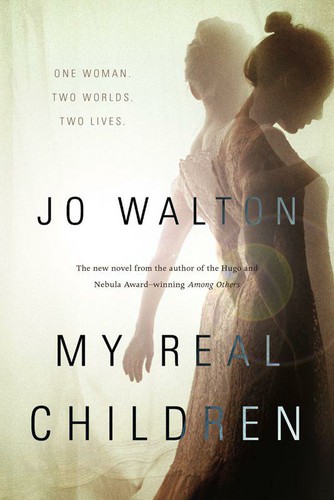Review: My Real Children [★★★★★]
My rating: ★★★★★
Read From: 26 May 2014 – 2 June 2014
Goal: Awards
Patricia is 88 or 89 years old. She's living in a nursing home. Her nurses make daily notations on her chart: confused, less confused, very confused.
She gets most confused when she thinks about her children: does she have four or three? Did she have five stillbirths or none? When Cathy comes to visit, she knows Cathy is one of her four children. But when Philip comes to visit, she knows Philip is one of her three children.
Her memories of the last 60 years are all doubled. There are the memories of the life where she married Mark, had four children, President Kennedy was assassinated, and the moon has a research base. Then there are the memories of the life when she didn't marry Mark, had three children, President Kennedy was involved in a nuclear missle exchange, and the moon has an armed military base.
Her memories of her early life aren't doubled. She clearly remembers growing up in Twickenham and attending Oxford. She'd made one crucial choice. One day, in a little phone box in a corridor in The Pines, and Mark had said that she would have to marry him, now or never.
Patricia's current, confused, state forms the framing story for the novel. My Real Children starts and ends at the conclusion of Patricia's life. For the rest, Jo Walton transports us back in time to 1933, when Patsy Cowan was 7 years old. She then moves us through her life to the fateful moment in 1949 when Mark Anston demanded that Patricia marry him "now or never".
From that point on, the story alternates between the life in which Patricia said "yes" to Mark and the life in which she said "no" to him. One chapter will take us through a short period of Tricia's life and the next will take us through the corresponding period in Pat's life. Alternating back and forth, through the years, we saw how her decision rippled through her life, creating two very different people.
Realistically, I'm not convinced that this book qualifies as science fiction. There's the fact that the story covers two alternate views of one life and that Patricia can remember both sets of personal histories. And there's the fact that both sets of histories contain a moon base. But that's it. There's nothing in there that's beyond current science and technology. There are no machines or gadgets that created Patricia's two lives or allow her to step between them. It is, quite simply, a story about one person and the two possible paths that her life could have taken.
I enjoyed this book very much. We often talk about how decisions, such as marriage, can change the course of a person's life. It's one thing to talk about that, in a casual way. It's another thing to see it lived out, over the course of one woman's life. I found the story to be moving and I loved the way that Jo Walton set it up so that neither life was clearly "better" than the other. They were different, but each had its own joys and sorrows.
The book ends on a poignant note, reminding us that both lives mattered. At the very end, Patricia thinks back to the crucial moment and tries to decide which life she'd pick, if she could pick just one.
She felt her strong young body that she had never appreciated when she had it, constantly worrying that she didn’t meet standards of beauty and not understanding how standards of health were so much more important. She bounced a little on her strongly arched young feet. She felt again the Bakelite of the receiver in her hand and heard Mark’s voice in her ear. “Now or never!”
Now or never, Trish or Pat, peace or war, loneliness or love?
She wouldn’t have been the person her life had made her if she could have made any other answer.
I love that ending. I can definitely recommend this book as one worth reading.
This entry was tagged. Book Review Review
